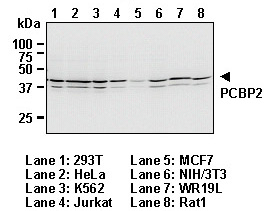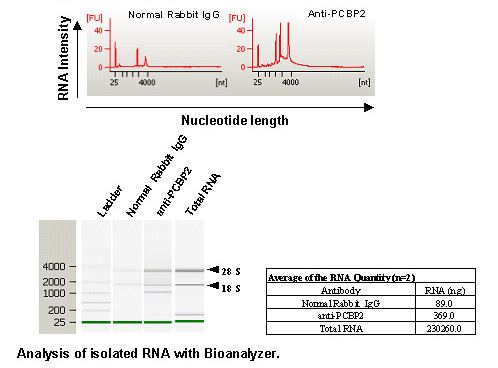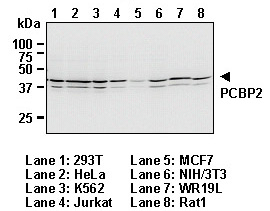Anti-PCBP2 (Human) pAb
| Code | Size | Price |
|---|
| MBL-RN025P | 200 ul | £458.00 |
Quantity:
Prices exclude any Taxes / VAT
Overview
Host Type: Rabbit
Antibody Isotype: Affinity Purified Ig
Antibody Clonality: Polyclonal
Regulatory Status: RUO
Target Species:
- Human
- Mouse
- Rat
Applications:
- Immunoprecipitation (IP)
- RIP
- Western Blot (WB)
Shipping:
4°C
Storage:
-20°C
Images
Documents
Further Information
Applications:
WB - 1 ug/mL for chemiluminescence detection system IP - 5 ug/500 uL of cell extract from
5 x 106 cells RIP - 15 ug/500 uL of cell extract from 1.5 x 107 cells
Background:
Poly(rC)-binding proteins (PCBPs) are cellular RNA-binding proteins, characterized by their triple KH structure and by their poly(C)-binding specificity. The 3 KH domains are not only involved in nucleic acid binding but also mediate protein-protein interactions within the RNP complexes. It binds specifically to polypyrimidine tracts within the 3' UTR of target mRNAs through KH domains. PCBPs are expressed as 4 isoforms in cells. PCBP1 and PCBP2 are predominantly expressed in the nucleus and can shuttle from the nucleus to the cytoplasm, while PCBP3 and PCBP4 are expressed to a less extent in the cytoplasm. The most characterized gene regulated by PCBP1 and PCBP2 is the α-globin gene, and the accumulated α-globin mRNA is known to account for approximately 95% of total cellular mRNA during terminal erythroid differentiation. Specific binding of PCBPs to 3? UTR of mRNA is associated with the stabilization of α-globin mRNA. Microarray analysis of human mRNAs present in a specific subset of PCBP2-RNP complexes also showed a potential involvement of PCBP2 in transcription factor expression via association with their mRNA; further, the enrichment of PCBP2 mRNA in PCBP2-RNP complexes suggested that PCBP2 expression may be subject to posttranscriptional autoregulation.
Concentration:
1 mg/mL
Description:
Posttranscriptional regulation of gene expression is a ribonucleoprotein-driven process, which involves RNA binding proteins (RBPs) and non-coding RNAs that affect splicing, nuclear export, subcellular localization, mRNA decay and translation. The RNP Immunoprecipitation-Chip (RIP-Chip), RIP-Seq and RIP-RTPCR allow the identification of multiple RNA targets of RBPs globally and within the context of a cell extract. Antibodies specific to the RNA binding protein of interest are used to co-immunoprecipitate the RNA binding protein and the associated subset of mRNAs. The mRNA content is interrogated using standard microarray or sequencing technology. RIP-Certified Antibody is validated for use in RNP Immunoprecipitation (RIP) in conjunction with the RIP-Assay kit distributed from MBLI. Its ability to immunoprecipitate mRNAs and RBPs complex was confirmed by quantitative and qualitative analysis on NanoDrop, Bioanalyzer and RT-PCR or microarray.
Formulation:
200 ul volume of PBS containing 50% glycerol, pH 7.2. No preservative is contained.
Gene IDs:
Human: 5094 Mouse: 18521
Immunogen Translated:
Internal region synthetic peptide binding KLH, human PCBP2
Reactivity:
This antibody reacts with human PCBP2 on Western blotting, Immunoprecipitation and RNP Immunoprecipitation.
Shelf Life:
1 year
Source:
This antibody was purified from rabbit serum by affinity column chromatography. The rabbit was immunized with KLH conjugated synthetic peptide, corresponding to internal region of human PCBP2.
Target:
PCBP2
References
1)
Waggoner, S. A., and Liebhaber, S. A., Mol. Cell. Biol. 23, 7055-7067 (2003)
2)
Chkheidze, A. N., and Liebhaber, S. A., Mol. Cell. Biol. 23, 8405-8415 (2003)
3)
Makeyev, A. V., and Liebhaber, S. A., RNA 8, 265-278 (2002)








